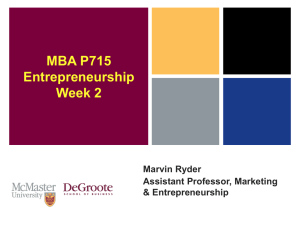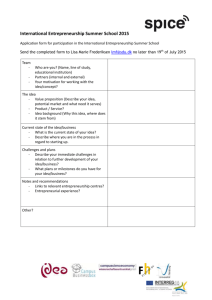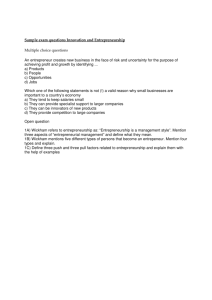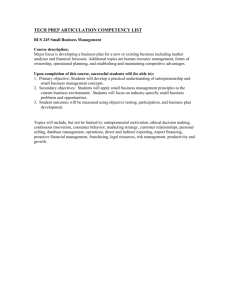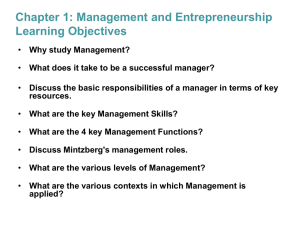Loving to Teach Those Who Think Like an Entrepreneur
advertisement
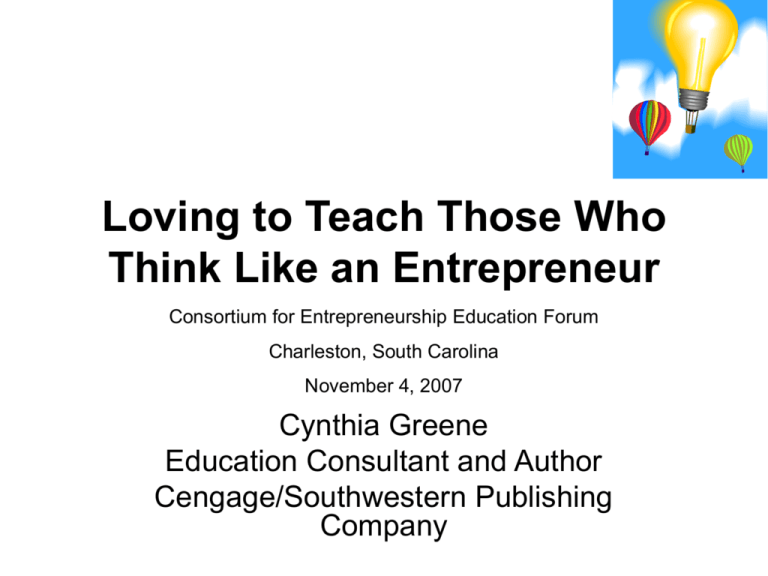
Loving to Teach Those Who Think Like an Entrepreneur Consortium for Entrepreneurship Education Forum Charleston, South Carolina November 4, 2007 Cynthia Greene Education Consultant and Author Cengage/Southwestern Publishing Company What are Our Learners Like? • Generation M Learners – Born: 1982-1991 • • • • Do they think the same? Do they value the same things? Do they learn in the same ways? Do they want the same type of training? Media exposure By age 21, the average person will have spent • • • • • 10,000 hours playing video games 200,000 emails 20,000 hours TV 10,000 hours on a cell phone Under 5,000 hours reading – Prensky, 2003 Gen “M” students versus Baby Boomer Instructors Comfort zones differ Students Multitasking Pictures, sound, video Random access Instructors Single or limited tasks Text Linear, logical, sequential Interactive and networked Independent and individual Engaging Spontaneous Disciplined Deliberate ―adapted from Himes, 2004 What can you do to adapt to Gen “M”? • Make learning interactive and experiential • Consider peer-to-peer approaches • Utilize real-world applications • Emphasize information literacy in courses • Encourage reflection • Create opportunities for synthesis • Use informal learning opportunities The Challenge - Simply Put • Our kids are spending 6 ½ hours per day using some form of media. • That’s 44 hours a week plugged in. – Equivalent to a full-time job plus a little overtime. • How does the typical teacher engage, motivate, communicate with, entertain, and instruct a generation of kids raised on 40-plus hours a week of media recreation? • A good teacher will design lessons that include three or four different activities instead of lecturing all period or giving kids handouts to complete. But how can that compete with a world in which students have their attention shifted every three seconds by the change of a camera angle, or swerving action of a video game, accompanied by swings in plot, color and music? How Entrepreneurship Can Motivate Today’s Learner • Why should entrepreneurship and small business receive more attention in the classroom? – Two-thirds of college students intend to be entrepreneurs at some point in their careers • Most business school textbooks stress large rather than small firm examples – Individuals with more education are more likely to become entrepreneurs, and they are more likely to open a business employing more people – Classrooms are filled with potential innovators • Key is to provide necessary skills that will allow them to foster these talents and start new businesses Why Study Entrepreneurship? • Small businesses – Total approximately 23 million in the United States • Approximately 75% have no employees – – – – – Represent 99.7% of all employer firms Employ half of all private sector employees Pay 44.3% of the total U.S. private payroll Generate 60 to 80 percent of net new jobs annually Create more than 50 percent of non-farm, private gross domestic product – Are employers of 39% of high tech workers – Made up 97% of all identified exporters and produced 29% of the known export value in FY 2001 – Two-thirds of new firms survive at least two years; 49.6 percent for four years Need for Hands-On Entrepreneurship Education • Gallup Poll Results – – 85% of high school students said nation’s schools should do more to teach about entrepreneurship and starting a business 70% of high school students surveyed expressed a strong interest in starting and running their own business • • • • • • – – Only 27% reported taking a course that taught about business or entrepreneurship Highest scores on a test of entrepreneurial knowledge • – To be my own boss To earn lots of money To use my skills and abilities To overcome a challenge Help community/provide jobs To build something for the family Description of an entrepreneur, example of a franchise, and supply and demand Lowest scores on a test of entrepreneurial knowledge • Typical way to raise capital, purpose of profits, and small business and job creation Students Say They Learned Little or Nothing About . . . . • How Business works • Compared to other subjects – U.S. History – Science – English or American Literature – Mathematics 85% 24% 16% 16% 7% Put Your Ideas into Action • Focus on central concepts and principles of entrepreneurship • Involve students in problem-solving investigations and other meaningful tasks • Culminate in realistic products Why Put Ideas in Action • Motivate students by engaging them in their own learning Before Project Based Activities After Project Based Activities A Successful Entrepreneur Should Be Three People in One Entrepreneur Manager Technician The visionary, the dreamer The planner, organizer The doer Craves control Sees problems in events Likes to be in charge of work flow Lives in future Lives in past Lives in present Thrives on change Clings to status quo Interested in how to do things --From THE E-MYTH REVISITED by Michael E. Gerber Typical Small Business Owner Entrepreneur Manager Technician From THE E-MYTH REVISITED by Michael Gerber What does all this mean for business education? • Even if students don’t start their own business, they probably will work for a small business. • Small businesses want entrepreneurial skills – Ability to engage in creative problem solving and critical thinking – Flexible workers who can take on responsibility and learn new things Ideas in Action Basic business skills Career interests Development of a business plan –Brings together writing, math, speaking, teamwork, technology use, data analysis and global awareness How to Educate Students • Teach an Entrepreneurship course • Integrate in existing business courses • Integrate in other courses Entrepreneurship Course • Teach a one- or two-semester course • Teach basic information students need • Have students develop a business plan for a business idea • Let students start the business Businesses Are Built With Ideas • Business Plans Build the Foundation for Success – Take students step-by-step through the entire process of owning their own business Create a business plan as students learn about components Get Students Ready to Run Their Own Businesses • Businesses are Built with Ideas – Students need to learn how others took ideas and turned them into action • Use Examples with Real-World Content – Successes – Failures What to Include • • • • • • Should You Become an Entrepreneur? Entrepreneurs in a Market Economy Develop a Business Plan Identify and Meet a Market Need Market Your Business Distribution, Promotion, and Selling What to Include • • • • • • • Select a Type of Ownership Locate and Set Up Your Business Plan and Track Your Finances Operations Management Human Resource Management Risk Management Management for the Future Ways to Enhance Learning • Provide learning opportunities that reinforce and expand lesson concepts – Emphasize teamwork activities – Highlight the pitfalls of real entrepreneurs and include critical thinking questions to help students analyze the situations Assess Student Learning • End of Lesson Exercises – Help students go beyond lesson content with questions that really test their knowledge – Provide opportunities for cross-curricular reinforcement of lesson concepts – Ask students questions that test their understanding School-Based Enterprises • Precious Memories--personalized calendars • Advertising Advocates--marketing the video yearbook--enrolled in Media Tech • Accessories--purses, jewelry, etc. • The Bead Company--bracelets • Fan Fanatics--customized t-shirts • Events--Memorable Machines and Vendor Fair How to Get Started • Start-up cash from fund raiser – Charge for services (copying, printing, etc.) • Prepare a business plan • Weekly Work Reports and Work Plans • • • • • Presentations for principal Make prototypes Grand Opening Weekly financial reports End of Semester Report and Presentation Integrate in Existing Business Courses • Units in courses – Accounting--Set up books for a business idea they have – Computer Applications--Design letterhead, business cards, and fliers for a business – Computer Applications--Design a multimedia presentation about a business idea for a space in a local shopping mall – Desktop Publishing—Design a magazine cover that features a famous entrepreneur Integrate in Existing Business Courses • Marketing – Make a business plan for a school store – Design a web page for a business on the Internet • Cooperative Education Program – Teach entrepreneurship to elementary students – Complete a unit on entrepreneurship and market a product Entrepreneurial Stories • Gadgetsleeves – Katelin Shea – New York Entrepreneurial Stories • Jx2 Productions – Andrew Jensen – Massachusetts Entrepreneurial Stories • LogicLotus – Omar Faruk – New York LogicLotus | Formerly BlueStreamCorp Entrepreneurial Stories • Alps Technology & • Alps Lawn Company – Joseph Pascaretta – Michigan Inspire Your Students • Look for stories in your community. • Share them with your students! What Students Say About Studying Entrepreneurship • How to start a business • Learned the importance of differentiating their product/service • Improved computer and presentation skills • Learned how to find and use resources Loving To Teach Those Who Think Like an Entrepreneur

